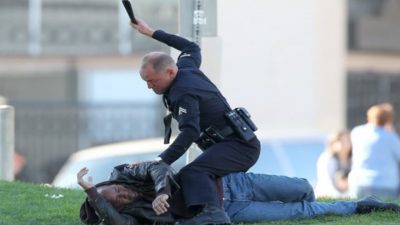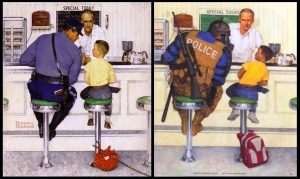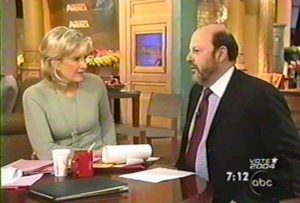![]() CALIFORNIA POLICE EXCESSIVE FORCE LAWYER CASES
CALIFORNIA POLICE EXCESSIVE FORCE LAWYER CASES
Jerry L. Steering, Esq., is a Police Misconduct Attorney; both civil and criminal. “Civil”, meaning suing police officers and their employing agencies for various Constitutional and state law claims. “Criminal”, in the sense that almost always following the police abusing (i.e. beating-up, tasing, pepper-spraying, etc.) a civilian, they routinely procure, or a attempt to procure, the filing of at least a misdemeanor Count of violation of Cal. Penal Code §148(a)(1); resisting / obstructing / delaying a peace officer engaged in the lawful performance of his/her duties. Section 148(a)(1) is otherwise known in police circles as “Contempt Of Cop”; (i.e. maybe not getting on the ground fast enough, or failing to walk-over to the officer fast enough; some type of failing the attitude test), is in itself, vague, ambiguous and unintelligible. It is used every day to oppress those who voice their dissatisfaction with the police.
Mr. Steering’s law practice involves representing persons in Southern California. He is also a member of the State Bar of Georgia, and had also litigated cases in Georgia, Alabama and the District of Columbia. He is an expert in police brutality / excessive force and false arrest cases, and has been litigating these cases since 1984.The great majority of Mr. Steering’s law practice is defending bogus criminal cases against the victims of abuse by the police, and suing police officers and other government officials, for claims such as false arrest, police brutality / excessive force, malicious prosecution, and other “Constitutional Torts.”
Police Misconduct is rampant and condoned and defended by the command structure of most, if not all, modern police agencies. See, Orange County Sheriff’s Department police torture videos, and other police beating videos throughout the Country. There is a “Blue Code of Silence” between and among peace officers throughout the nation, and everyone knows this. This is no startling revelation. The County of Los Angeles has itself released a public document, acknowledging the existence of, and actually condemning, the Sheriff’s Department’s own rogue gangs of sadistic jailers at the Los Angeles County Central Men’s Jail. See, The Citizens Commission on Jail Violence September 28, 2012.
In 2012, a retired LA County Sheriff’s Department Captain, Bob Olmsted, told the LA Times, that the L.A. County Men’s Central Jail was, essentially, a torture chamber, run by these rogue jailer gangs of sadistic sociopaths (Minnesota Viking logo tattoos on on their ankles.) Discipline for beatings was not existent, and torturing inmates was actually required for jailer gang initiation. See, “L.A. County sheriff’s official tells of jail brutality”, LA Times, July 7, 2012. See also, “L.A. County jail violence sheriff’s fault, panel says”, LA Times, September 28, 2012. Rival Sheriff’s Department jailer gangs even got into a rumble between the “3000 Boys” (the third floor jailers) and the “2000 Boys” (the second floor jailers) at a Sheriff’s Department Christmas party.
Even as long ago as 1992, the Ninth Circuit Court of Appeals held in a published decision that the “Vikings” gang of Deputy Sheriff’s at the Lynwood Sheriff’s Station, that they were a Neo-Nazi white supremacist gang within the LA County Sheriff’s Department. See, Thomas v. County of LA, et al., 978 F.2d 504 (1992.)
The leader of the sociopath / sadistic torturing faction of the LA County Sheriff’s Department, recently retired LA Sheriff’s Department Undersheriff Paul Tanaka, is now running for Sheriff of LA County. Paul Tanaka was, or maybe still is, a member of the Nazi Sheriff’s Department gang the “Vikings”; who have the Minnesota Vikings logo tattooed on their legs.
Following Captain Bob Olmsted’s revelations to the FBI, the FBI did an undercover investigation at the LA County Men’s Central Jail. The FBI investigation resulted in the Indictment of 18 Deputy Sheriffs and their Supervisors for torturing inmates and obstructing the FBI’s investigation by hiding prisoners in the county jail population. These 18 Indictments of LA County Sheriff’s Department personnel resulted in the very recent resignation of L.A. County Sheriff Lee Baca.
Nonetheless, the body politic tolerates the existence, and the perpetuation of an ongoing unwritten agreement among and between peace officers, to falsely report, and, if necessary, to thereafter conspire with officers who they may not yet even know, to falsely testify, about event(s), if the potential or apparent criminal, administrative and civil liability of a fellow officer is at stake.
After all, in the primary category of cases that truly are “false arrests” in the most malevolent sense of the word, “Contempt of Cop cases“, the only reason that there’s an arrest of a civilian at all, is because the police officer has beaten-up / tortured another; usually to self-medicate rather their frail and easily bruise-able egos. If you’re reading this article, the odds are, that either you or a loved one or friend has been beaten-up by the police and are being criminally prosecuted for allegedly battering the officer or somehow “resisting” the officer.
Modern police agencies are afraid of losing their “power” in, and over, a community. That “power” base (i.e. ability to influence the politicians and the public), is based in large part, on the public “supporting the police”. That popular support is based upon a belief by the body politic, that: 1) police officers are well trained and know and respect your Constitutional rights, 2) they’re basically honest, 3) that only a small percentage of them would commit perjury, 4) that the force that the police use on people is almost always justified (if not legally, then morally), and 5) that the police are capable of policing themselves. Although none of these beliefs are accurate, one cannot ignore the belief system of the majority of the white / affluent American populace, in understanding why police officers routinely, and without a second thought, falsely arrest civilians, and commit other outrages against innocents.
Wrongful police beatings, accompanied by their sister “false arrests”, are a common and every day occurrence. These beating / arrests are no longer limited to persons of color. Soccer Moms, airline pilots and school teachers, beware: because of the great (and ever expanding) powers being given to police officers by the Supreme Court, described below, in a very real way, you no longer have the right to question, protest or challenge police actions, since to do so usually results in your being physically abused and falsely arrested on trumped of charges of essentially, “Contempt Of Cop”; (i.e. maybe not getting on the ground fast enough, or failing to walk-over to the officer fast enough; some type of failing the attitude test.)
Unfortunately, because of institutional pressures (i.e. “ratting out fellow officer not a good career move”) and the obvious political and practical consequences of not backing-up the their fellow officers, the norm in today’s police profession, is for peace officers to falsely arrest civilians, and to author false police reports, to procure the bogus criminal prosecutions (i.e. to literally “frame”) of those civilians whose Constitutional rights and basic human dignity have been violated by them. After all; how would it look if a police officer beat you up, and didn’t arrest you. Because most police officers, including those that step-over Constitutional “line in the sand“ (i.e. beating another, falsely accusing civilians of crimes), are not true sociopaths, when they falsely charge you with a crime, it isn’t usually too serious of one. Most are bogus claims for violation of Cal. Penal Code § 148(a)(1), because the crime of “resisting or obstructing or delaying a peace officer who’s engaged in the performance of his/her duties” is incredibly ambiguous, and can (ingenuously or ignorantly) be applied to almost any conduct by a person (i.e. the defendant yelled at me for restraining [torturing] the “suspect”, so he delayed me from arresting the “suspect” because I had to look his way and take a protective stance in the events that the defendant charged at me.)
Pursuant to the routine procedure to persecute their victims, police officers arrest their victims, author bogus reports that accuse their victims of crimes against the officer, preserve evidence favorable to them, and “flush” evidence adverse to their usually fabricated and contrived claims of criminal conduct by their victims; you, the public. His law practice involves serving, among other places, Orange County, and the Orange County cities shown below. Mr. Steering is an expert in dealing with your pending bogus criminal action, in a way that is going to best protect your ability to down the road sue the police, and obtain compensation and redress for your beating, your false arrest, and your malicious criminal prosecution. Mr. Steering also specializes in obtaining evidence and framing issues for adjudication in the initial criminal action against the police misconduct victim (the defendant being criminally prosecuted), and discovering evidence in that criminal case, to seal the police defendants’ fate in the civil action after the criminal case is disposed of in your favor.
Unfortunately, because of institutional pressures (i.e. “ratting out fellow officer not a good career move), and the obvious political and practical consequences of not backing-up the their fellow police officers, the norm in today’s police profession, is for police officers to falsely arrest their “victims”, and to author false police reports to procure the bogus criminal prosecutions (i.e. to literally “frame”) of those persons whose Constitutional rights and basic human dignity have been violated.
For example, the crime of “battery on a peace officer (Cal. Penal Code §§ 242 / 243(b)), is almost always, in reality, battery by a peace officer; otherwise known as “Excessive Force” or “Unreasonable Force”, which the United States Supreme Court has classified since 1989, as an “unreasonable seizure” of a person under the Fourth Amendment to the United States Constitution (See, Graham v. Connor, 490 U.S. 386 (1989).) Accordingly, in many cases where the police use “excessive force” (“police brutality”) on civilians, the excessive force victims get criminally prosecuted, for crimes that they didn’t commit; usually for crimes such as “Resisting / obstructing / delaying a peace officer in the lawful performance of their duties (Cal. Penal Code § 148(a)(1)), assault on a peace officer (Cal. Penal Code §§ 240 / 241) and resisting officer with actual or threat of violence (Cal. Penal Code § 69.) After all, how would it look if the police beat-up a civilian, and just left the scene, as opposed to arrested the person that they just beat-up? Not very good for the police; ergo, the old police motto: “You hook’em, you book’em.”
Legally, What Is Excessive / Unreasonable Force?
Prior to 1989, the federal courts looked to the substantive due process clause of the Fourteenth Amendment to the Constitution to “pigeon hole” claims of excessive force by a peace officer against civilians. See, Johnson v. Glick That standard was that the conduct of the police officer had to be “shocking to the conscience”; the standard still used for those uses of force by a police officer that don’t involve efforts by police to use force against civilians to seize them, such as arresting or detaining civilians. Johnson v. Glick involved the use of force by prison guards against a convict; not either a free civilian that an officer is trying to “seize” (detain or arrest), or a “pre-trial detainee“; someone who has already been “seized” (i.e. arrested, and in the County Jail; awaiting arraignment, other pre-trial proceedings, or trial.)
However, when it comes to a police officer using force to arrest or detain another, the standard for the use of force is decreed by the Supreme Court, to emanate out of the Fourth Amendment’s prohibition against unreasonable searches and seizures.
The Fourth Amendment to the United States Constitution provides:
“Amendment IV.
The right of the people to be secure in their persons, houses, papers, and effects, against unreasonable searches and seizures, shall not be violated, and no warrants shall issue, but upon probable cause, supported by oath or affirmation, and particularly describing the place to be searched, and the persons or things to be seized.”
Thus, the Fourth Amendment’s prohibition against unreasonable searches and seizures is, since 1989, the legal standard by which to judge whether a police officer used excessive force when seizing a civilian.
What Is Excessive / Unreasonable Force?
The United States Supreme Court has defined “Excessive Force”as follows:
“The “reasonableness” of a particular use of force must be judged from the perspective of a reasonable officer on the scene, rather than with the 20/20 vision of hindsight. See Terry v. Ohio, supra, 392 U.S., at 20-22, 88 S.Ct., at 1879-1881. The Fourth Amendment is not violated by an arrest based on probable cause, even though the wrong person is arrested, Hill v. California, 401 U.S. 797, 91 S.Ct. 1106, 28 L.Ed.2d 484 (1971), nor by the mistaken execution of a valid search warrant on the wrong premises, Maryland v. Garrison, 480 U.S. 79, 107 S.Ct. 1013, 94 L.Ed.2d 72 (1987). With respect to a claim of excessive force, the same standard of reasonableness at the moment applies: “Not every push or shove, even if it may later seem unnecessary in the peace of a judge’s chambers,” Johnson v. Glick, 481 F.2d, at 1033, violates the Fourth Amendment.
The calculus of reasonableness must embody allowance for the fact that police officers are often forced to make split-second judgments in circumstances that are tense, uncertain, and rapidly evolving about the amount of force that is necessary in a particular situation.
“Where, as here, the excessive force claim arises in the context of an arrest or investigatory stop of a free citizen, it is most properly characterized as one invoking the protections of the Fourth Amendment, which guarantees citizens the right “to be secure in their persons . . . against unreasonable . . . seizures” of the person . . . . . . . Determining whether the force used to effect a particular seizure is “reasonable” under the Fourth Amendment requires a careful balancing of ” ‘the nature and quality of the intrusion on the individual’s Fourth Amendment interests’ ” against the countervailing governmental interests at stake. Id., at 8, 105 S.Ct., at 1699, quoting United States v. Place, 462 U.S. 696, 703, 103 S.Ct. 2637, 2642, 77 L.Ed.2d 110 (1983). Our Fourth Amendment jurisprudence has long recognized that the right to make an arrest or investigatory stop necessarily carries with it the right to use some degree of physical coercion or threat thereof to effect it. See Terry v. Ohio, 392 U.S., at 22-27, 88 S.Ct., at 1880-1883. Because “the test of reasonableness under the Fourth Amendment is not capable of precise definition or mecha ical application,” Bell v. Wolfish, 441 U.S. 520, 559, 99 S.Ct. 1861, 1884, 60 L.Ed.2d 447 (1979), however, its proper application requires careful attention to the facts and circumstances of each particular case, including the severity of the crime at issue, whether the suspect poses an immediate threat to the safety of the officers or others, and whether he is actively resisting arrest or attempting to evade arrest by flight. See Tennessee v. Garner, 471 U.S., at 8-9, 105 S.Ct., at 1699-1700 (the question is “whether the totality of the circumstances justifies a particular sort of . . . seizure”).” (See, Graham v. Connor, 490 U.S. 386 (1989.))
As in other Fourth Amendment contexts, however, the “reasonableness” inquiry in an excessive force
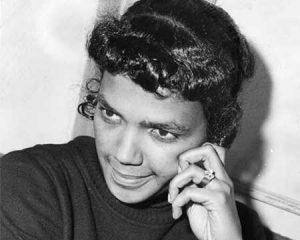
case is an objective one: the question is whether the officers’ actions are “objectively reasonable” in light of the facts and circumstances confronting them, without regard to their underlying intent or motivation. See, Scott v. United States, 436 U.S. 128, 137-139, 98 S.Ct. 1717, 1723-1724, 56 L.Ed.2d 168 (1978); See also, Terry v. Ohio, supra, 392 U.S., at 21, 88 S.Ct., at 1879 (in analyzing the reasonableness of a particular search or seizure, “it is imperative that the facts be judged against an objective standard”). An officer’s evil intentions will not make a Fourth Amendment violation out of an objectively reasonable use of force; nor will an officer’s good intentions make an objectively unreasonable use of force constitutional. See, Scott v. United States,supra, 436 U.S., at 138, 98 S.Ct., at 1723, citing United States v. Robinson, 414 U.S. 218, 94 S.Ct. 467, 38 L.Ed.2d 427 (1973).
In Graham, we held that claims of excessive force in the context of arrests or investigatory stops should be analyzed under the Fourth Amendment‘s objective reasonableness standard, not under substantive due process principles. 490 U.S., at 388, 394. Because police officers are often forced to make split-second judgments in circumstances that are tense, uncertain, and rapidly evolving about the amount of force that is necessary in a particular situation, id., at 397, the reasonableness of the officers belief as to the appropriate level of force should be judged from that on-scene perspective. Id., at 396. We set out a test that cautioned against the 20/20 vision of hindsight in favor of deference to the judgment of reasonable officers on the scene. Id., at 393, 396. Graham sets forth a list of factors relevant to the merits of the constitutional excessive force claim, requir[ing] careful attention to the facts and circumstances of each particular case, including the severity of the crime at issue, whether the suspect poses an immediate threat to the safety of the officers or others, and whether he is actively resisting arrest or attempting to evade arrest by flight. Id., at 396. If an officer reasonably, but mistakenly, believed that a suspect was likely to fight back, for instance, the officer would be justified in using more force than in fact was needed (See, Saucierv. Katz, 533 U.S. 194 (2001).)
The federal courts have reduced all of this legal gobbledygook to jury instructions, that, supposedly, a person of regular intelligence can understand. The Ninth Circuit Court of Appeals Jury Instruction for excessive force instructs the jury:
“Ninth Circuit Model Civil Jury Instructions
9.22 PARTICULAR RIGHTS—FOURTH AMENDMENT—UNREASONABLE SEIZURE OF PERSON—EXCESSIVE (DEADLY AND NONDEADLY) FORCE
In general, a seizure of a person is unreasonable under the Fourth Amendment if a police officer uses excessive force [in making a lawful arrest] [and] [or] [in defending [himself] [herself] [others]. Thus, in order to prove an unreasonable seizure in this case, the plaintiff must prove by a preponderance of the evidence that the officer[s] used excessive force when [insert factual basis of claim].
Under the Fourth Amendment, a police officer may only use such force as is “objectively reasonable” under all of the circumstances. In other words, you must judge the reasonableness of a particular use of force from the perspective of a reasonable officer on the scene and not with the 20/20 vision of hindsight.
In determining whether the officer[s] used excessive force in this case, consider all of the circumstances known to the officer[s] on the scene, including:
1. The severity of the crime or other circumstances to which the officer[s] [was] [were] responding;
2. Whether the plaintiff posed an immediate threat to the safety of the officer[s] or to others;
3. Whether the plaintiff was actively resisting arrest or attempting to evade arrest by flight;
4. The amount of time and any changing circumstances during which the officer had to determine the type and amount of force that appeared to be necessary;
5. The type and amount of force used;
[6. The availability of alternative methods [to take the plaintiff into custody] [to subdue the plaintiff;]
[7. Other factors particular to the case.]“
THE PROBLEM WITH GRAHAM’S “REASONABLE OFFICER STANDARD” IN THE REAL WORLD – THE WATCHMAN GETS TO MAKE HIS OWN RULES THAT REGULATE HIS OWN CONDUCT.
When asked about a 1974 Papal Encyclical by Pope Paul VI, condemning the use of contraception, former Secretary of Agriculture Earl Butz stated: “He don’t play-a-da game; he don’t make-a-da rules.” In the police profession, they do play that “game”, and now they get to “make-a-da rules.” The problem with the description of how “excessive force” is defined, is not the Supreme Court’s strong emphasis on the officer’s conduct being based on an “objective” standard; they hypothetical reasonable officer in the abstract. The problem is, that the standards in the police profession for what is “reasonable” or otherwise proper police conduct in a given situation, are generally neither the creature of legislation (i.e. state law requiring the audio recording of custodial police interrogations) nor the product of any judicially created mandate, duty, or prohibition (i.e. Constitutional limits on conduct and judicially created “exclusionary rule”.) The conduct of “the objectively reasonable officer”; that standard that the Supreme Court attempted to describe in Graham v. O’Connor and Saucier v. Katz, is created by the very persons whose conduct the Fourth Amendment is supposed to impose limits on. Thus, in a very real sense, the Supreme Court has set the standard (“objectively reasonable officer”) that the Fourth Amendment requires, but has delegated the details of what’s reasonable or not, to the police.
It’s letting the regulated enact their own regulations. It’s like letting the local power company, set the rate of profit that they should make; set the formula for how the amount of profit is determined; set how much they can spend on public relations (since they’re a monopoly), and how, when, by whom and in what manner, they should be inspected, what they can and can’t do in their industry, and every other aspect of the business. If they want to all use tasers on civilians, then that’s reasonable. If they all want to pepper-spray persons because their hands in their pockets, then that’s reasonable. If they want to prone-out everyone at gun point that they detain, then that’s reasonable. At the end of the day, in the real world police world, if the technique, method, procedure, policy or practice reduces the danger level to the officer, you can bet that, eventually, they will find a way to justify such technique, method, procedure, policy or practice , and make such otherwise unreasonable behavior, “reasonable”, for no other reason than the police would prefer to act that way; Constitutional or not. You see the problem. The police have an old slogan: “It’s better to be judged by 12, then carried by 6.” It’s another way of saying, I’ll act in a way that is in my self interest; not yours, and if I happen to trample your Constitutional rights, so be it. My insuring my safety from any potential threat trumps any annoying Constitutional rights of yours.
THE PROBLEM OF QUALIFIED IMMUNITY, COMPOUNDS THE PROBLEM CREATED BY GRAHAM
In a nutshell, the Qualified Immunity is an immunity from a lawsuit (from being sued at all) for violation of a civilian’s Constitutional rights, when those rights were actually violated, but a reasonably well trained police officer could have believed that his conduct did not constitute a Constitutional violation. So, even if the police officer actually violated your Constitutional Rights, he/she may be immune from suit, because the law was not clearly established enough at the time of the violation, to hold a police officer liable for his conduct. This is a doctrine “contrived” by the conservative members of the Supreme Court (since 1981), to ensure that you can’t do anything about (or at least do a whole lot less about) your Constitutional Rights being trampled by the government.
The Perversion, Ad Nauseam, Of The Qualified Immunity Doctrine, To Protect Peace Officers From Civil Liability; “Reasonably Acting Unreasonably”
So, for example, if the police come-up with a whole new technique to restrain people, such as a with a taser, or pepper-spray, or pepper-balls, or water-balls, or hobbling (police hog tying), or a shock-belting, or stun-gunning, the officer may very well be entitled to qualified immunity from being sued for the misuse of any of the above-mentioned devices; not because its “reasonable”, but because the police just use those devices in such manners; thereby giving the Courts an excused to relieve the police officer from liability for the damage caused by his violation of the Constitutional Rights of civilians:
An officer will be denied qualified immunity in a 1983 action only if (1) the facts alleged, taken in the light most favorable to the party asserting injury, show that the officers conduct violated a constitutional right, and (2) the right at issue was clearly established at the time of the incident such that a reasonable officer would have understood her conduct to be unlawful in that situation. Saucier, 533 at 201-02; Liberal v. Estrada, 632 F.3d 1064, 1076 (9th Cir. 2011.) To assist the development of constitutional precedent, we exercise our sound discretion to follow Saucier’s conventional two-step procedure and address first whether the Torres Family has alleged the violation of a constitutional right. See, Pearson, 129 S.Ct. at 818.” target=”_blank” rel=”noopener”>An officer will be denied qualified immunity in a 1983 action only if (1) the facts alleged, taken in the light most favorable to the party asserting injury, show that the officers conduct violated a constitutional right, and (2) the right at issue was clearly established at the time of the incident such that a reasonable officer would have understood her conduct to be unlawful in that situation. Saucier, 533 at 201-02; Liberal v. Estrada, 632 F.3d 1064, 1076 (9th Cir. 2011.) To assist the development of constitutional precedent, we exercise our sound discretion to follow Saucier’s conventional two-step procedure and address first whether the Torres Family has alleged the violation of a constitutional right. See, Pearson, 129 S.Ct. at 818.
However, a trial court should not grant summary judgment when there is a genuine dispute as to the facts and circumstances within an officers knowledge or what the officer and claimant did or failed to do. Id.”(Saucier v. Katz, supra.)
Qualified Immunity Is A Self-Fulfilling Policy; The Court’s Don’t Provide Either Reasonably Discernible Guidelines, Or Clear Border Type Rulings
The problem with the description of how “excessive force” is defined, is not the Supreme Courts strong emphasis on the officers conduct being based on an objective standard; the hypothetical reasonable officer in the abstract. The problem is, that the standards in the police profession for what is reasonable or otherwise proper police conduct in a given situation, are generally neither the creature of legislation (i.e. state law requiring the audio recording of custodial police interrogations) nor the product of any judicially created mandate, duty, or prohibition (i.e. Constitutional limits on police conduct, such as the judicially created exclusionary rule.) The conduct of the objectively reasonable officer; that standard that the Supreme Court attempted to describe in Graham v. Connor and Saucier v. Katz, is created by the very persons whose conduct the Fourth Amendment is supposed to impose limits on. Thus, in a very real sense, the Supreme Court has set the standard (objectively reasonable officer) that the Fourth Amendment requires, but has delegated the details of what’s reasonable or not, to the police.
This is quite problematic, as the Bill of Rights was created for the Courts to protect us from the police / government, so when the police define “what’s reasonable force”, in a very real way, the Fourth Amendment to the United States Constitution, one of those rights in the Bill of Rights, is defined by the police, rather than the Courts. There are cases where the Courts will step-in and ban a particular police practice, but those cases are far and few between, and when the Courts do so, they often create more of legal mess than existed before such judicial intervention. See, for example, the trilogy of Ninth Circuit Court of Appeals taser cases. In the first case, Bryan v. McPherson (9th Circuit 12/28/09), the Ninth Circuit Court of Appeals held that using a taser on a man in his underwear who was 20 feet away and merely verbally going-off on the police officers, was so obviously unlawful, that no reasonably well trained police officer could have believed that it was constitutional to tase the man. Two weeks later, in Mattos v. Argarano (9th Cir. 1/12/10), another three judge panel of the Ninth Circuit Court of Appeals held that the police tasing of a domestic violence victim did not constitute unreasonable force, since the police were trying to grab the her husband, and she happened to just be between the man and the police. The Mattos court held that their decision didn’t conflict with the Bryan v. McPherson (9th Circuit 12/28/09), because the use of the taser in that case was so obviously unreasonable, that the defendant police officers would not be entitled to qualified immunity from suit.Thereafter, two and one-half months later in Brooks v. City of Seattle (9th Cir.March 26, 2010), the Ninth Circuit held that it didn’t constitute the use of unreasonable force for a police officer to tase a pregnant woman three times in her neck to get her out of her car. Having now painted themselves into a corner, the Ninth Circuit decided to grant “en banc review” of all three 2010 taser cases; one en banc panel of judges decided the rehearings of the Mattos v. Argarano and Brooks v. City of Seattle cases, and one en banc panel reheard the Bryancase. The results were almost as confounding, as were the original wrongly decided decisions. In the Mattos and Brooks cases, the Ninth Circuit held that although the defendant police officers did violate the plaintiffs’ Constitutional right to be free from the use of unreasonable force upon their persons (i.e. the tasers), that the officers were nonetheless entitled to qualified immunity from suit, because the law on the use of tasers was not clearly established at the time of the Constitutional violations:
“We now hold that, although Plaintiffs in both cases have alleged constitutional violations, the officer Defendants are entitled to qualified immunity on Plaintiffs 1983 claims because the law was not clearly established at the time of the incidents.”
In the rehearing on the Bryan v. McPherson case, the Ninth Circuit reversed themselves, and awarded qualified immunity to the defendant officers; also because the law regarding the use of tasers was not clearly established at the time of the Constitutional violations:
“Officer MacPherson appeals the denial of his motion for summary judgment based on qualified immunity. We affirm the district court in part because, viewing the circumstances in the light most favorable to Bryan, Officer MacPhersons use of the taser was unconstitutionally excessive. However, we reverse in part because the violation of Bryans constitutional rights was not clearly established at the time that Officer MacPherson fired his taser at Bryan on July 24, 2005.”
WHY THE POLICE CRIMINALLY PROSECUTE THEIR VICTIMS
Unfortunately, because of institutional pressures (i.e. “ratting out fellow officer not a good career move), and the obvious political and practical consequences of not backing-up the their fellow officers, the norm in todays police profession, is for peace officers to falsely arrest their “victims”, and to author false police reports to procure the bogus criminal prosecutions (i.e. to literally “frame” others) of those civilians whose Constitutional rights and basic human dignity have been violated; to justify what they did, and to act in conformity with that justification. The excessive force victims get criminally prosecuted, for crimes that they didn’t commit; usually for crimes such as “Resisting / obstructing / delaying a peace officer in the lawful performance of their duties (Cal. Penal Code § 148(a)(1)), assault on a peace officer (Cal. Penal Code § 240 / 241), “battery on a peace officer (Cal. Penal Code § 242 / 243(b)(which is almost always, in reality, battery by a peace officer; otherwise known as “Excessive Force” or “Unreasonable Force”),and resisting officer with actual or threat of violence (Cal. Penal Code § 69.) Section 69 is a “wobbler” under California law; a crime that the government can charge as either a misdemeanor or a felony. This charge is usually reserved for cases in which the police use substantial force on the innocent arrestee (the real “victim”), and need to falsely claim more violent / serious conduct by the “victim” to justify their outrages.
So, for example, the crime of “battery on a peace officer” (Cal. Penal Code § 242 / 243(b)), is almost always, in reality, “battery by a peace officer”; otherwise known as “Excessive Force”; an “unreasonable seizure” of a person under the Fourth Amendment to the United States Constitution (See, Graham v. Connor, 490 U.S. 386 (1989).)
If you have been the victim of Excessive Force by a police officer, please check our Section, above, entitled: “What To Do If You Have Been Beaten-Up Or False Arrested By The Police“. Also, please click on “Home“, above, or the other pages shown, for the information or assistance that we can provide for you. If you need to speak with a lawyer about your particular legal situation, please call the Law Offices of Jerry L. Steering for a free telephone consultation.
Thank you, and best of luck, whatever your needs.
Law Offices of Jerry L. Steering
Jerry L. Steering, Esq.

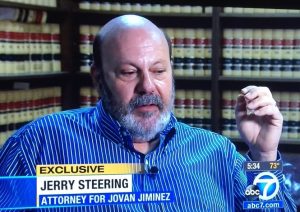 CALIFORNIA POLICE EXCESSIVE FORCE LAWYER CASES
CALIFORNIA POLICE EXCESSIVE FORCE LAWYER CASES

